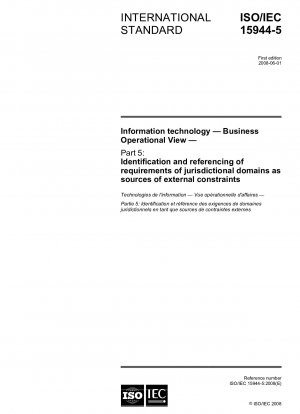ISO/IEC 15944-5:2008
Information technology - Business Operational View - Part 5: Identification and referencing of requirements of jurisdictional domains as sources of external constraints
- Standard No.
- ISO/IEC 15944-5:2008
- Release Date
- 2008
- Published By
- International Organization for Standardization (ISO)
- Latest
- ISO/IEC 15944-5:2008
- Scope
- The modelling of a business transaction through scenarios and scenario components is done by specifying the applicable constraints through explicitly stated rules. The Open-edi Reference Model identified two basic classes of constraints, namely "internal constraints" and "external constraints" (see further Annex G). ISO/IEC 15944-4 focuses on internal constraints with a specific focus on doing so from an economic ontology perspective. External constraints apply to most business transactions. Jurisdictional domains are the primary source of external constraints on a business transaction. The primary purpose of this part of ISO/IEC 15944 is to address specific aspects of business semantic descriptive techniques in order to be able to support legal requirements in modelling business transactions, i.e. in the form of jurisdictional domains as sources of external constraints. As such, this part of ISO/IEC 15944 addresses fundamental, i.e. more primitive, requirements of the legal environment, as represented through jurisdictional domains, on business transactions and also integrates the requirements of the information technology and telecommunications environments. This part of ISO/IEC 15944 contains a methodology and tool for specifying common classes of external constraints through the construct of "jurisdictional domains". It does so, following the approach already taken by ISO/IEC 15944-1 and ISO/IEC 15944-2 through the use of explicitly stated rules, templates and Formal Description Techniques (FDTs). At the same time, a set of external constraints of a jurisdictional domain lends itself to being modelled through scenarios and scenario components. For example, ISO/IEC 15944-1:2002, Annex I, 'Scenario descriptions using the Open-edi scenario template: "Telecommunications Operations Map" example' is a scenario of an external constraint of a jurisdictional domain, i.e. the USA, that provides a business process framework that provides the enterprise process required for a telecommunications service provider. Other examples of external constraints which lend themselves to being modelled as scenarios and scenario components include the customer clearance process of the World Customs Organization (WCO), one or more of the INCOTERMs, etc. In addition to the existing strategic directions of "portability" and "interoperability", the added strategic direction of ISO/IEC JTC 1 of "cultural adaptability" is also supported in this part of ISO/IEC 15944. Here, the fact that external constraints of jurisdictional domains are a primary factor in the choice of language and application of public policy are also addressed in this part of ISO/IEC 15944.
ISO/IEC 15944-5:2008 Referenced Document
- ISO 1087-1:2000 Terminology work - Vocabulary - Part 1: Theory and application
- ISO 2788:1986 Documentation; Guidelines for the establishment and development of monolingual thesauri
- ISO 3166-1 Codes for the representation of names of countries and their subdivisions — Part 1: Country code*, 2020-08-25 Update
- ISO 3166-2 Codes for the representation of names of countries and their subdivisions — Part 2: Country subdivision code*, 2020-08-25 Update
- ISO 3166-3:1999 Codes for the representation of names of countries and their subdivisions - Part 3: Code for formerly used names of countries
- ISO 4217:2001 Codes for the representation of currencies and funds
- ISO 5964:1985 Documentation; Guidelines for the establishment and development of multilingual thesauri
- ISO 639-2:1998 Codes for the representation of names of languages - Part 2: Alpha-3 code
- ISO/IEC 2382 Information technology - Vocabulary*, 2015-05-01 Update
- ISO/IEC 5218:2004 Information technology - Codes for the representation of human sexes
- ISO/IEC 6523-1:1998 Information technology - Structure for the identification of organizations and organization parts - Part 1: Identification of organization identification schemes
- ISO/IEC 6523-2:1998 Information technology - Structure for the identification of organizations and organization parts - Part 2: Registration of organization identification schemes
- ISO/IEC 7501-1:2005 Identification cards - Machine readable travel documents - Part 1: Machine readable passport
- ISO/IEC 7501-2:1997 Identification cards - Machine readable travel documents - Part 2: Machine readable visa
- ISO/IEC 7501-3:2005 Identification cards - Machine readable travel documents - Part 3: Machine readable official travel documents
ISO/IEC 15944-5:2008 history
- 2008 ISO/IEC 15944-5:2008 Information technology - Business Operational View - Part 5: Identification and referencing of requirements of jurisdictional domains as sources of external constraints
